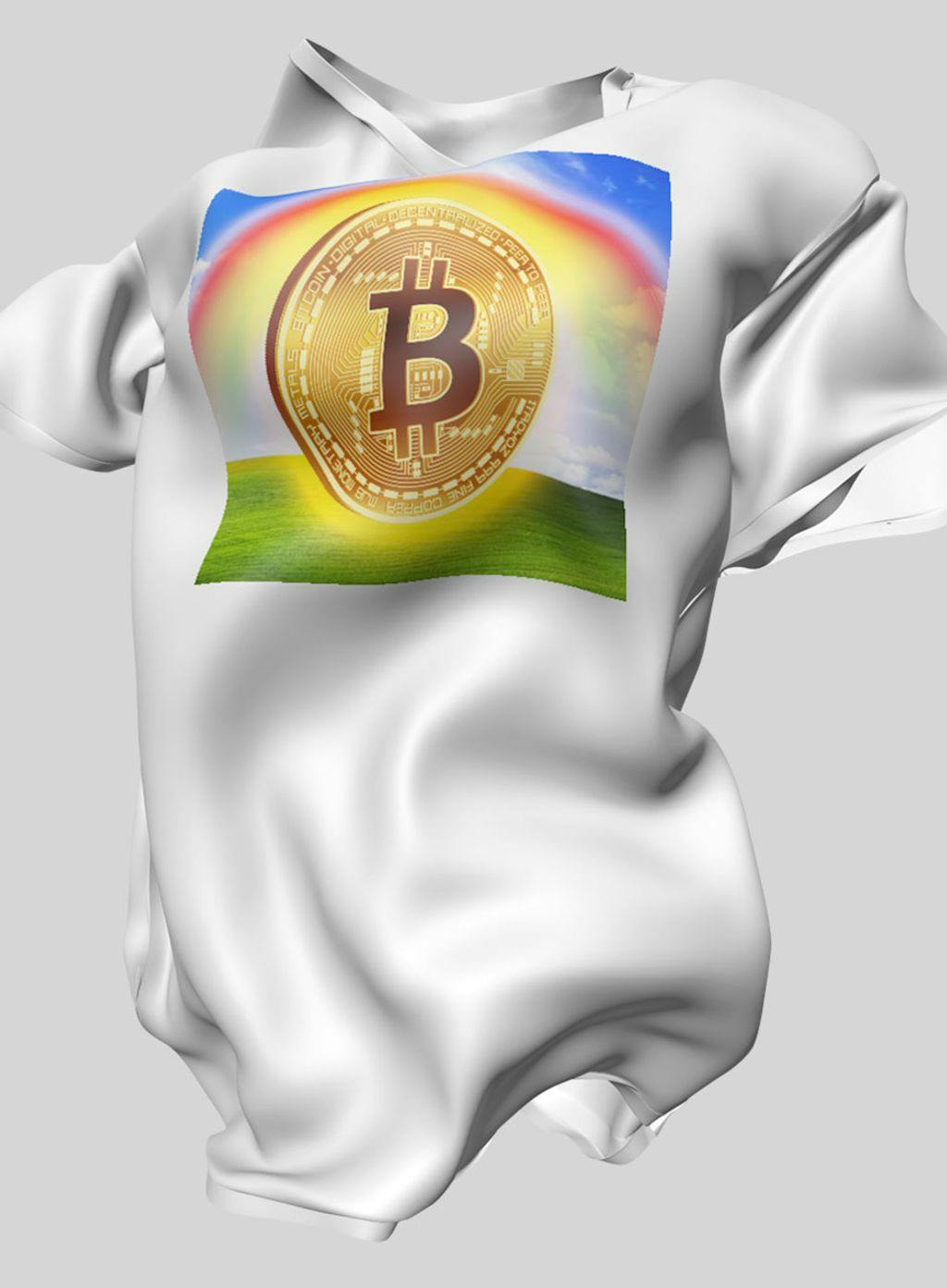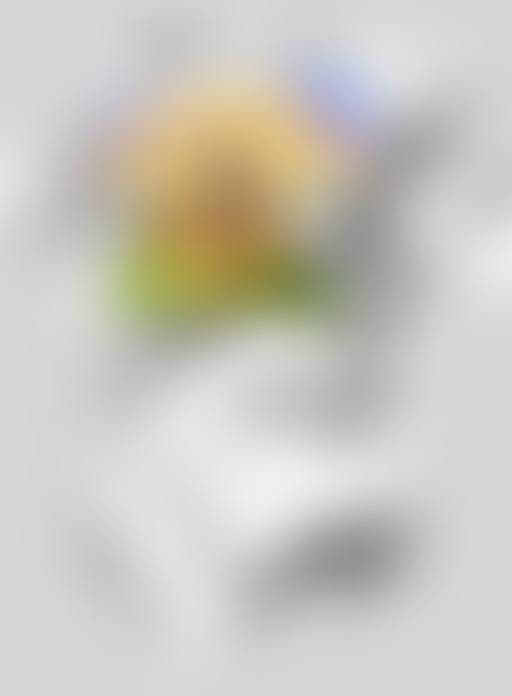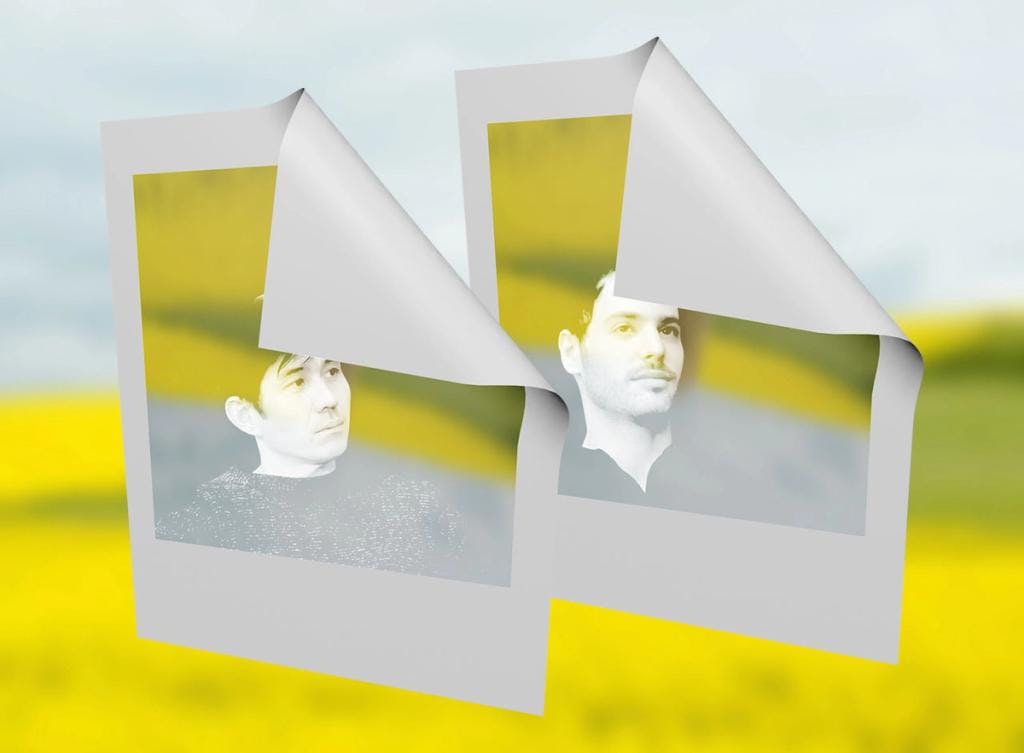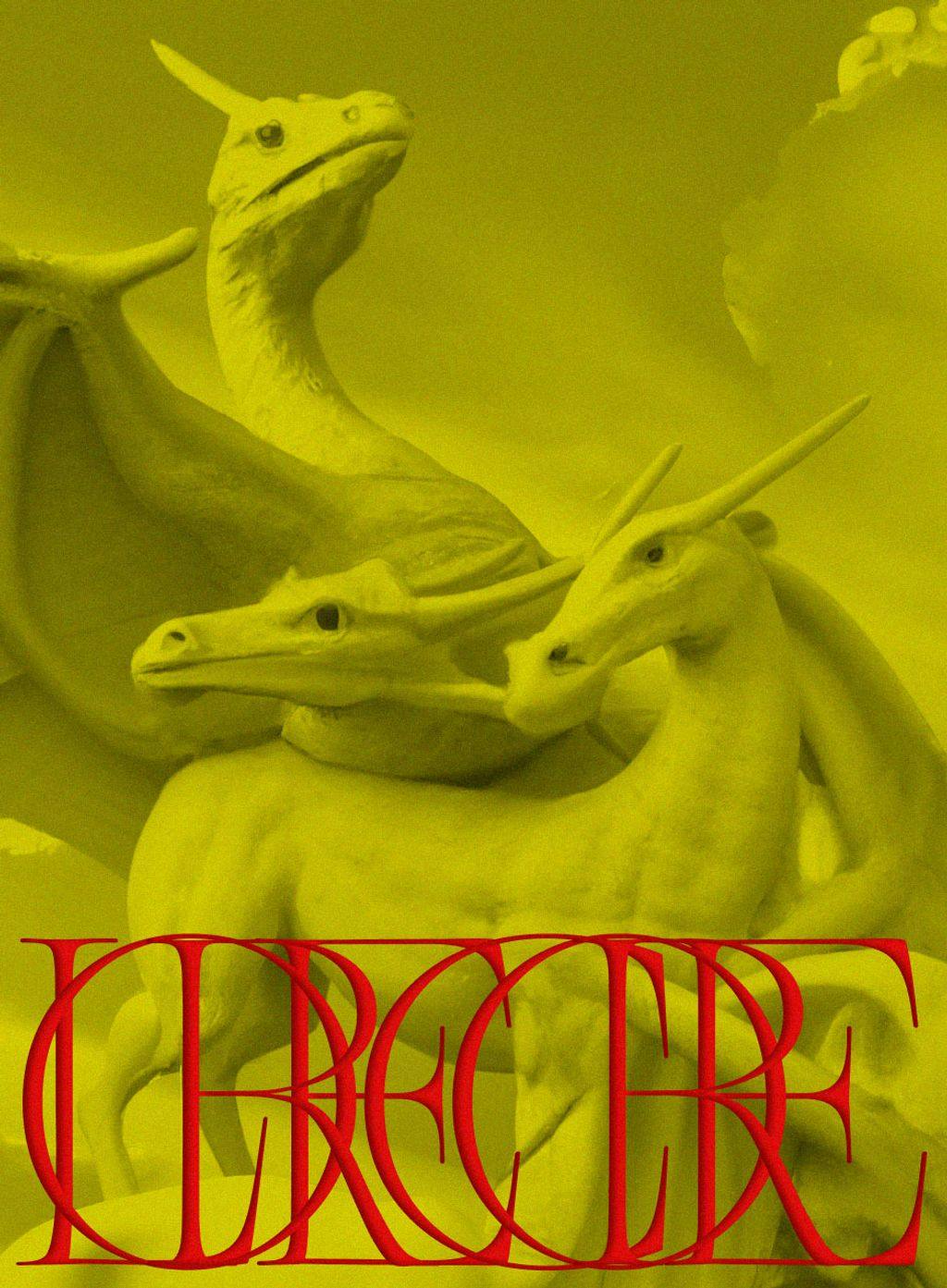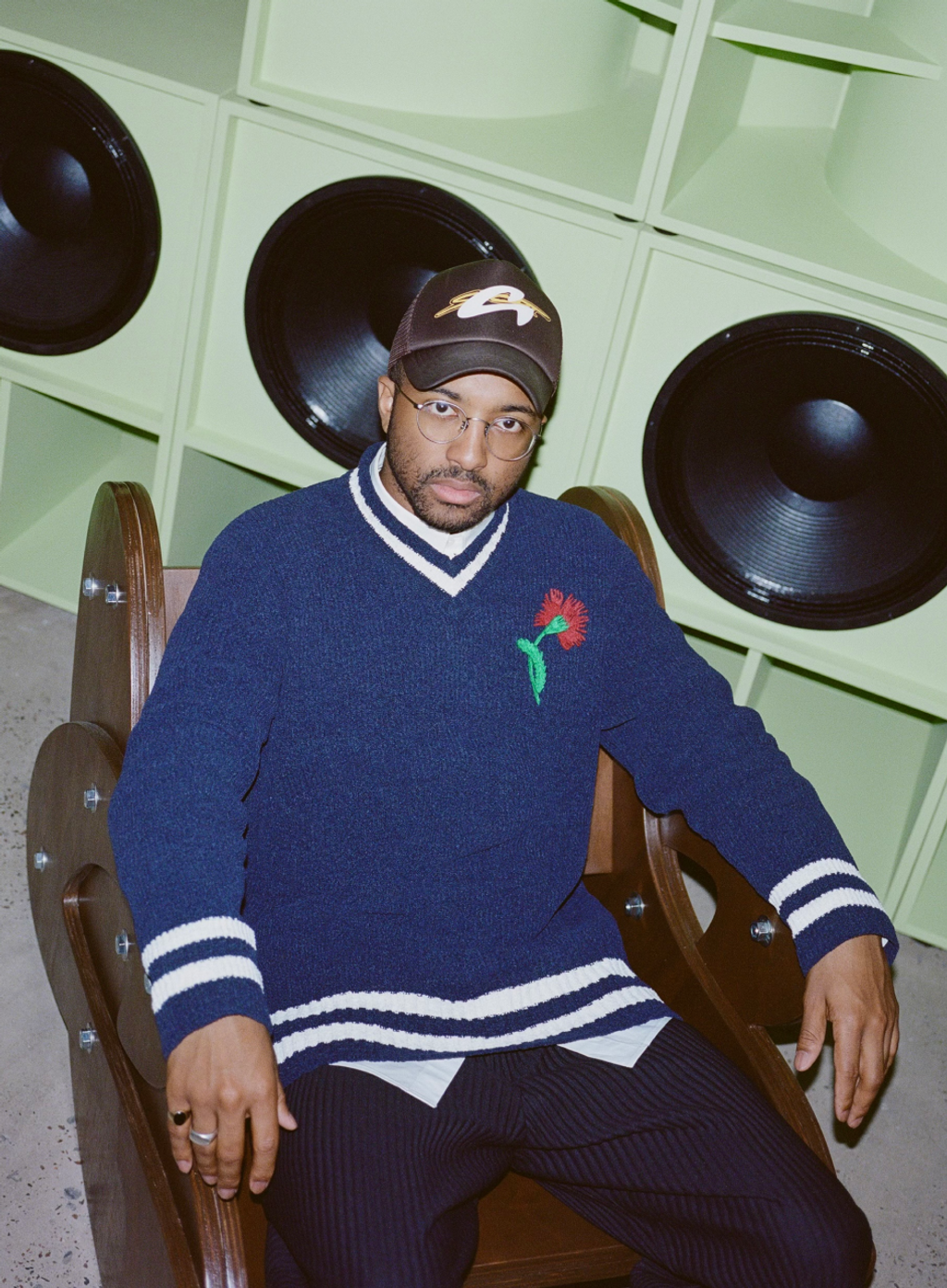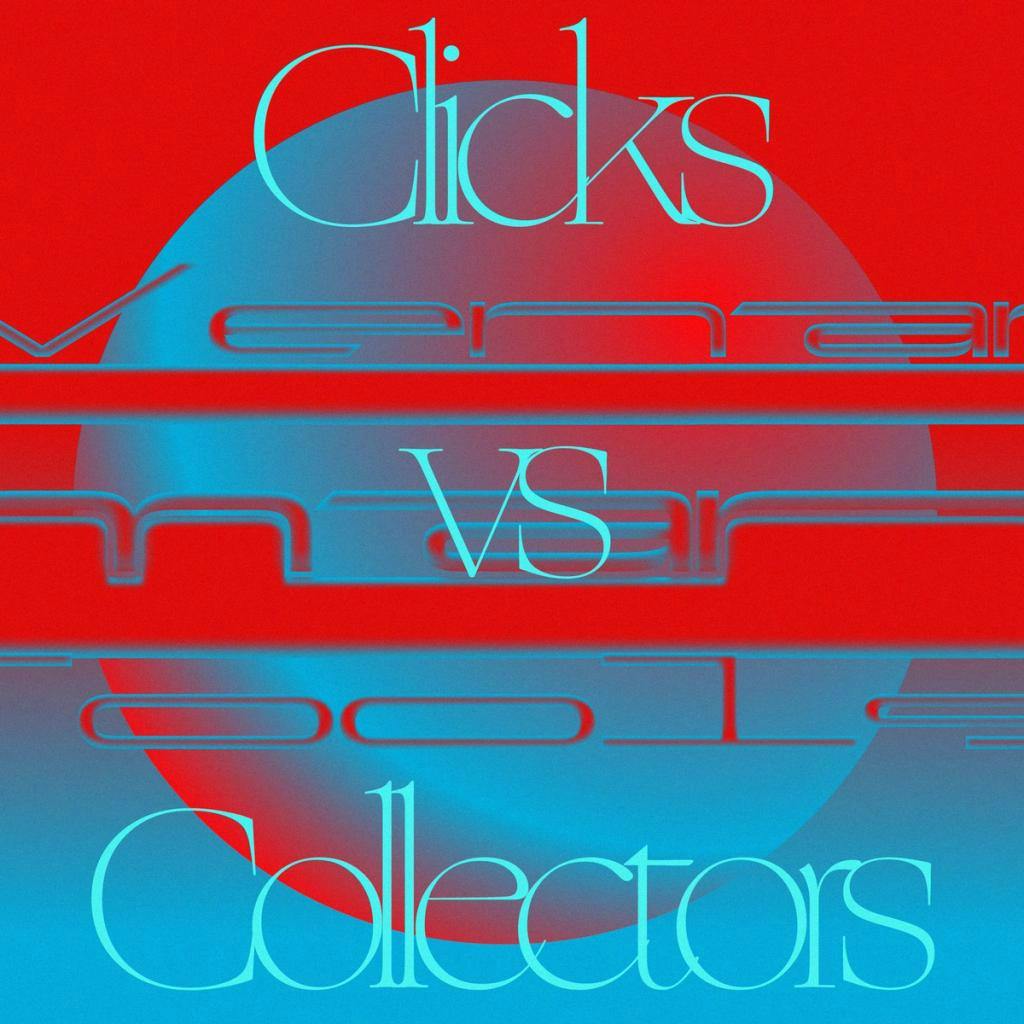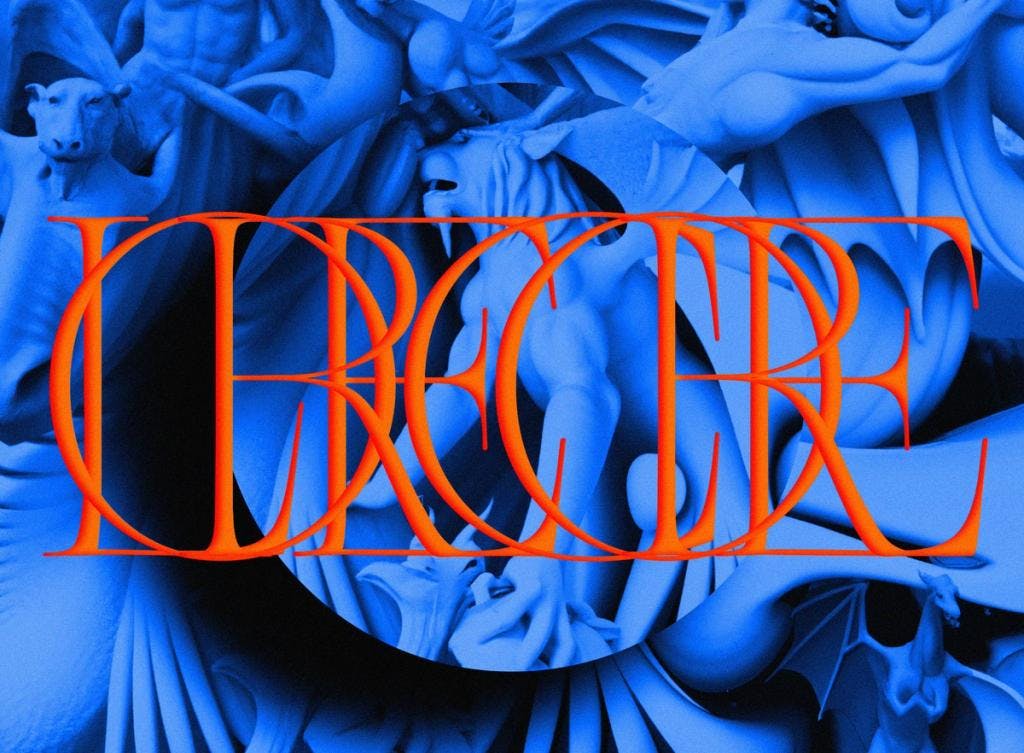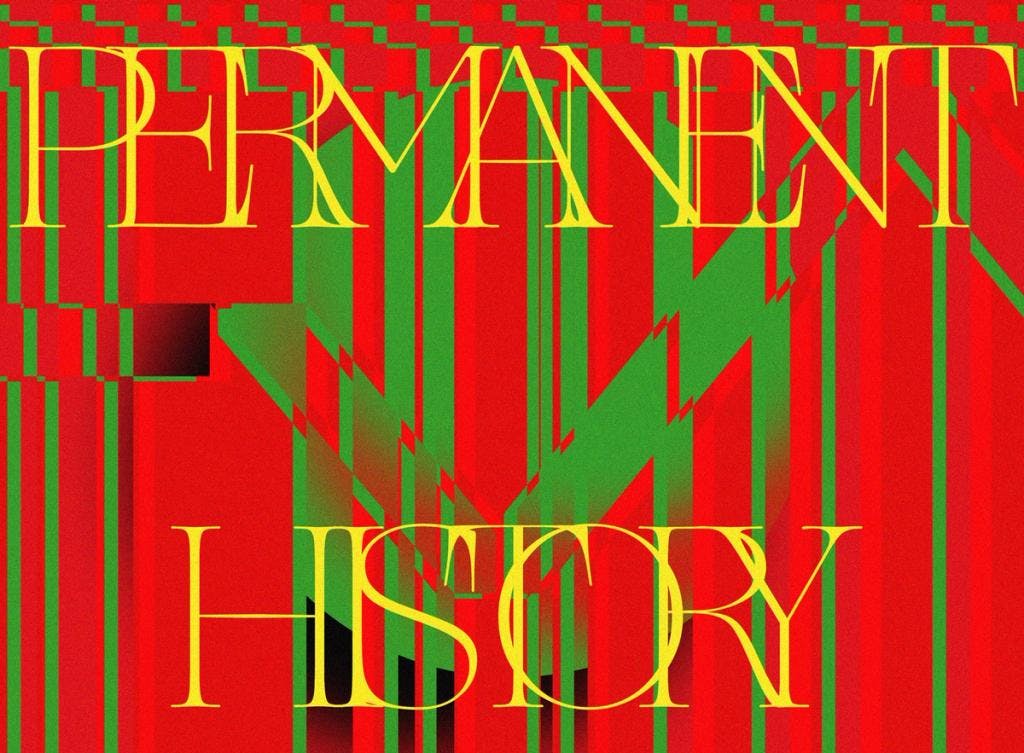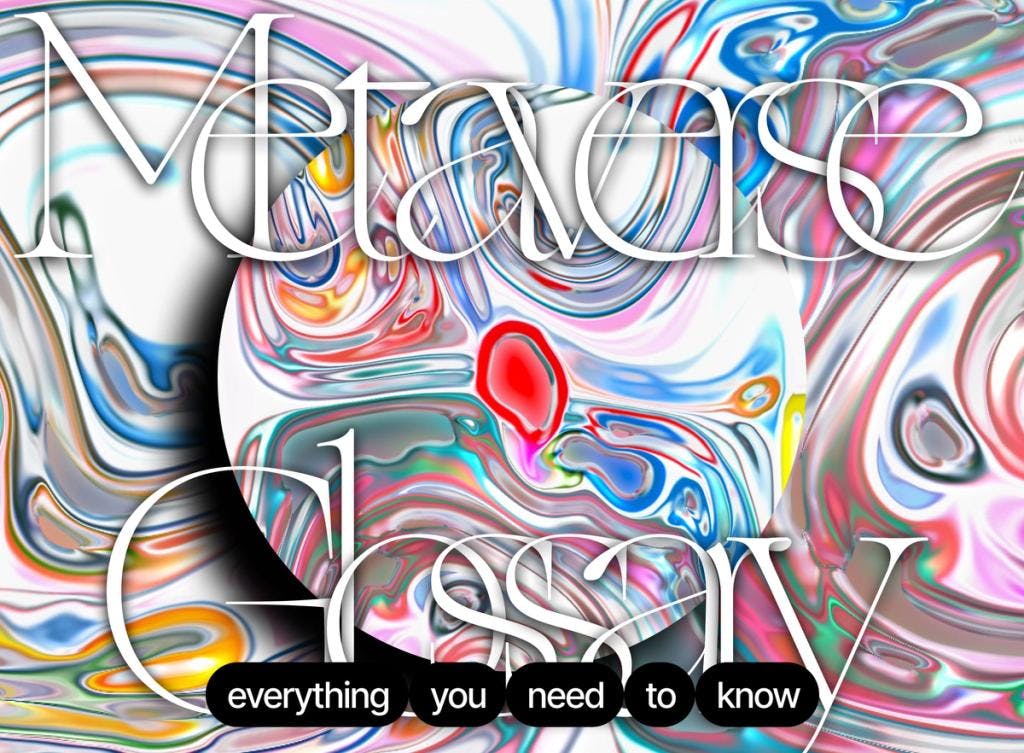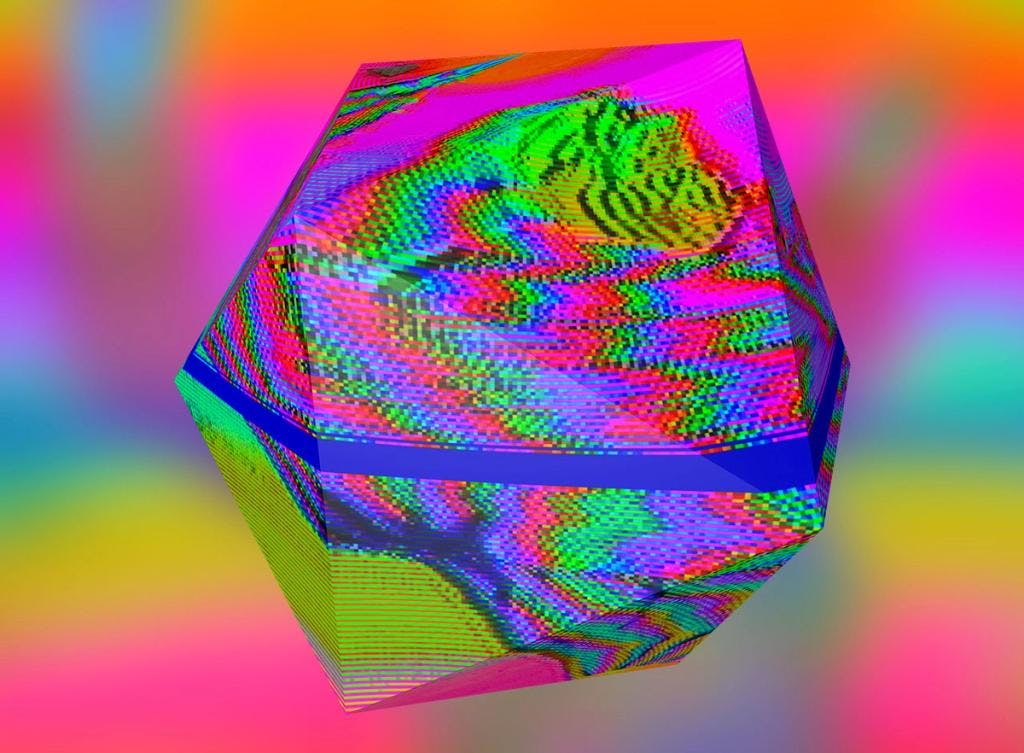


CupofNFT:The'It'Newsletter
Cup of NFT: The 'It' Newsletter
Elle and Gian Ferrer are tired of a Western-dominated NFT narrative
Corrine Ciani (ZORA): Who are you and how did you find your way into Web3?
Elle (Cup of NFT): I’m Elle, and I started the Cup of NFT newsletter. In 2020 I straight up said, ‘It's a new decade, it's about time I be a proper adult and learn about investing, because that's what proper adults seem to do.’ I fell so far down the hole that I ended up finding crypto. Then COVID happened and I got laid off at the end of March. So in April I thought, ‘I'm going to dive deeper into this whole Web3 thing.’ Having a month free made it easy to devote all my time to understanding everything.
One of the most important parts for me was when I discovered NFTs in the Bankless newsletter, which was technically through Axie Infinity, the Blockchain game. When DeFi and everything was happening, and transaction fees were too high and pricing me out, I still could play and make some money. That led me to the thesis that there are a lot of people like me who also need a way to make money, and there aren't a lot of people who have money who want to grow it and survive the gas fees on Ethereum. But a lot of people can gravitate to something like NFTs because it's visual—it doesn't need a lot of prior financial knowledge.
CC: So many people can relate to that, being that a massive amount of people got laid off and thought, ‘What do I do now?’
E: Right, and this was 2020, when crypto hadn't hit its parabolic highs and NFTs hadn't really taken off yet. I was trying to talk to other people about DeFi and nobody cared. One of the most validating things for me was when I was like, ‘Oh hey, you can make money playing this game.’ People actually listened to me, and that was my first inkling that DeFi is cool, but NFTs are just easier to understand and are easier to tempt people into.
CC: Is it the visual aspect of NFTs that you find most enticing and digestible?
E: I think that's a part of it. DeFi is labyrinthine, complex structures of money being moved around, and some people might not get that. But NFTs are just like buying and selling—it's very familiar. Axie Infinity comes in a mobile app that you can easily show people and watch videos. How do you even make a video demonstration of a concept like yield farming? It's just you clicking a bunch of numbers on the screen and then checking in over time, but it doesn't visually convey anything versus a lot of the extra content you can make with NFTs.
We're used to social media, so we're all used to all these visual mediums. We're part of clubs. We're used to being part of a Discord at this point because the pandemic has forced us to seek groups online.
CC: You found NFTs through the rabbit hole of crypto, but at what point did you decide to create Cup of NFT?
E: I wanted to speed-run my learning in DeFi by trying to write about it. That experience was a lot of fun and really forced me, again, to learn quickly about all of these things, because if I didn't understand a term or something, I had to research it and then understand it well enough to write it back to someone who was reading it. But I was so interested in this NFT thing. By then, I had already seen a brewing number of people getting into Axie Infinity, and NFTs were a form of visual medium that no one was really looking at then. I was just like, ‘All right, maybe I devote my 2021 to trying to write about NFTs on a more regular basis so I can expand my scope; I can make it a habit to constantly be looking at the NFT space, synthesize my insights on the space so that I can keep researching, and keep forming decisions regularly every week.’
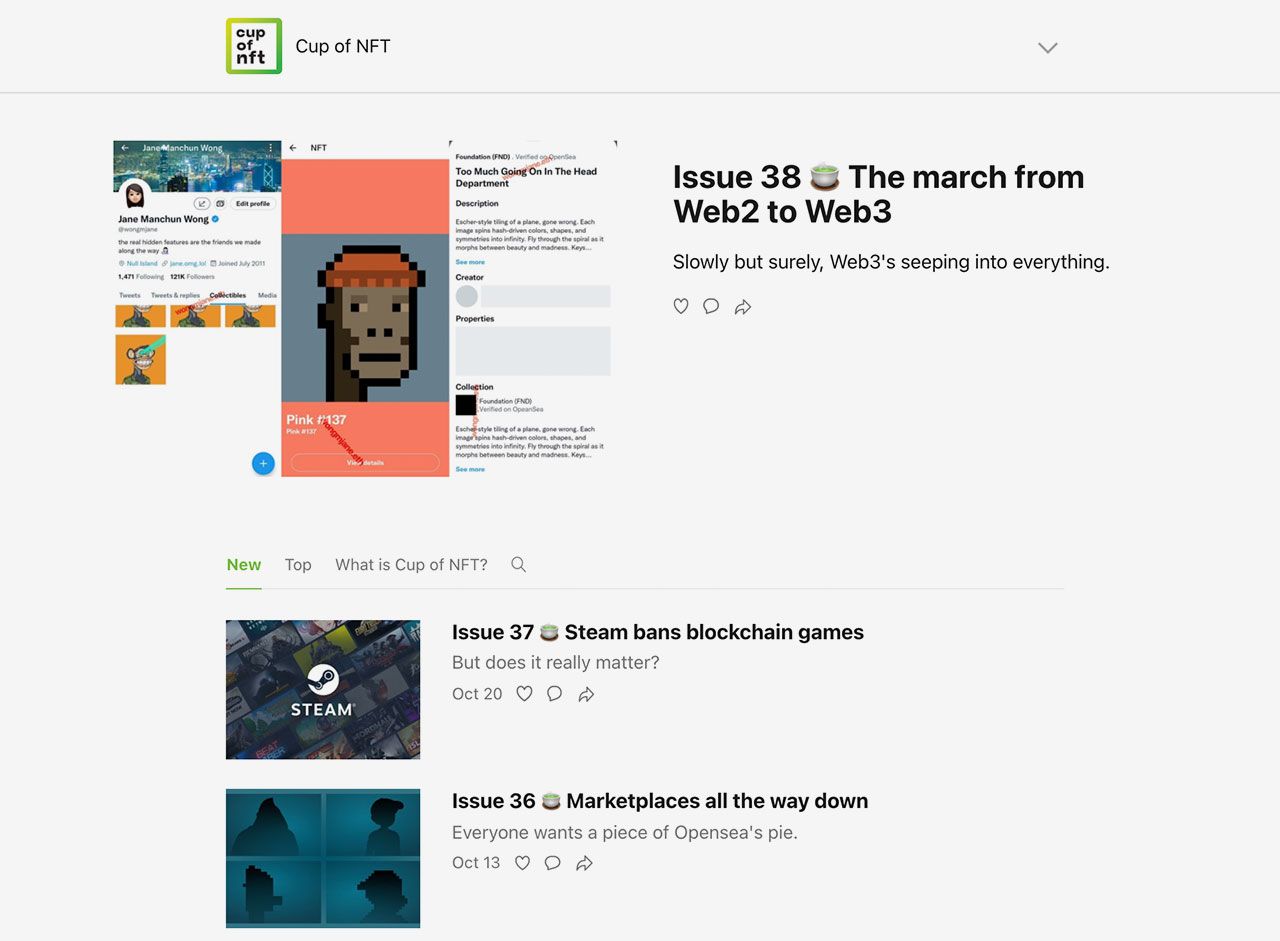
CC: Where does Gian Ferrer come into the picture? How is he involved at Cup of NFT?
E: Gian is also from the Philippines, and I was just really enthused that there was someone like me; he can also stay up late and I cannot [laughs]. So I reached out to him to chat and form a relationship when I first discovered him, because I thought, ‘Great, it's nice to have another person in the space.’ And then around May or June, I took a break due to some personal stuff and fatigue, and I had set this standard, but it was a little too much for one person to handle. So I reached out to Gian because I knew he was a graphic designer, and I was like, ‘Hey, would you be interested in helping me write this newsletter? Ideally I usually handle the cover story or the larger summary, but we have the reports. We have news and an artist section as well. Would you be interested in taking over the artist section on a more regular basis?’
To this day we've settled into that routine. We usually just share news and things that we like in a shared group chat, but he's the one who's now in charge of picking out artists and describing them, which has been great. Both of us also share strong beliefs about NFTs. NFTs shouldn't end up like Web2, where it's just a bunch of companies profiting off creators' talent—we're very staunch about that. We've definitely challenged ourselves to look beyond people just on Foundation. We really do genuinely love ZORA and the ethos. We look at creators and are just like, ‘You have a chance to really own your platform and your market, why settle for marketplaces charging 15% off of your sales?’
CC: How do you and Gian approach the newsletter and its curation?
E: We do have a bit of a preference for highlighting people of color or people that we think haven't really shown much; we're not going to do something if a person is already selling well. Gian does a fantastic job of finding artists of color in Bangkok and Southeast Asia, because he’s an artist and sees that scene more. When I was picking, I was running on visuals and asking, ‘How do they engage with the broader community?’ Because if they do that, then that's a sign that they are here to stay. It's hard to break through the noise, but it doesn't change the fact that there's still some great people out there making great work, and they are just as worthy for the spotlight.
CC: As a reporter in the crypto community, do you find there is misinformation being spread around?
E: I mean, it's also about incentives, right? There is definitely every incentive for someone without money to come into this space that looks like it's brimming with money. People suddenly becoming millionaires: that sells headlines. I can't really fault that. I think that we do try to look for personal connections; ideally, teams or projects that are doing well also get some of the credit or get some highlight.
It seems like the Web2 media machine is stepping in and influencing. I think they already have a foothold on influencing the narrative a little bit. It's not bad, but I don't want it to become another Web2 where it just gives opportunities for the West and America—places where there has already been opportunity—versus achieving the idea that there can be opportunities for everyone, no matter where you are, where you’re from, or what you look like.
CC: Right, that's the whole point of the Internet: endless opportunities regardless of where you're located. What excites you most in Web3 right now?
E: I'm still heavily fascinated by Play-to-Earn and Axie Infinity; I can't stop thinking about the implications of work and labor in the metaverse, because a lot of the people who are benefiting from it have absolutely no option otherwise in this pandemic. To me, that's one of the hallmarks of what crypto can enable: the utopia where it doesn't matter what you are or what you do—you just come in, do the work, and make money.
A lot of this profile-picture mania right now happens during US-time and it's unfortunately hard to participate. As I was saying, Gian is very much deep into DAOs, up at 3am still doing that stuff, but I cannot physically push myself there. So I think the thing that I keep puzzling over the most these days is, how can we enable a synchronous work opportunity? There's still a lot of us on this side of the world. Gian’s very strongly like, ‘How do we get people to participate in DAOs?’ and I'm just like, ‘How do we get more opportunities for everyone no matter where they are?’
CC: What are your thoughts on it?
E: It’s up to the DAOs themselves if they would like to be thoughtful about other timezones and being asynchronous, actually making updates, and taking the time to document progress—all of those little housekeeping things that actually help keep everybody in loop. What fascinates me about Play-to-Earn is that it doesn't really matter what time you log on: as long as the economy is functioning properly, you can just put your hours in. I think that’s potentially one method of getting there.
When Play-to-Earn kicked off, it was crazy how so many people understood it and were willing to dive into it. Hopefully, projects or any of these NFT-minting things get better about how they distribute their NFTs. For example, in the Parallel card game, when they distribute their NFTs, you could make a transaction after you reserve your packs at any point in that day, versus all of these general projects that are first come first serve, and if you're not there, you buy on a secondary market for a crazy markup.
Hopefully DAOs become more global, with people like Gian joining them and requesting for better time and work-life balance. On the other end, hopefully NFTs can be distributed more thoughtfully instead of just being like, ‘Show up or mint.’ If you have some contribution, be it Discord, social media, or something, you don't have to rush. We'll reserve it for you, mint it as you like, and then on the other hand, Play-to-Earn ideally. The economy's become more secure, so it can facilitate more opportunities for more people.
I'm not really interested in replicating what's been done before; can we actually do something for a new circle of people instead of recycling the same things over and over again?
CC: We’ve discussed how we don't want to revert to Web2, where corporations essentially run everything. Would you say that is what you fear for the future of crypto?
E: At the end of the day, that is my fear. There's a lot of artificial scarcity to access stuff like tools, and we're just like, ‘These are tools, these can help people!’ We've grown up being gated our entire lives. To this day, people say, ‘Oh, you can't use Stripe?’ And I'm like, ‘I cannot use a basic financial tool like Stripe if I wanted to monetize anything, simply because there hasn’t been interest in catering to my geography up to now.’ It takes years for that access to trickle down and be open for someone like me in a third world country that no one really rushes to support.
That's my fear: that the Web3 space becomes a conversation dominated by America and completely forgets that there's other people on the other side of the world who could also stand to benefit from all this tech and economic access. To this day, I'm fascinated by Axie Infinity, because the people who care about it the most are really the people who have had no access or a certain educational attainment, and they definitely aren't the type who would comfortably work remotely right now. I'm not really interested in replicating what's been done before; can we actually do something for a new circle of people instead of recycling the same things over and over again?
CC: Access is the only way to move this industry forward.
E: Yes. I have friends who are staying up very late, but it takes a toll on you at some point. Ideally, it doesn't become the norm and it doesn't last forever because it puts a strain on people in this timezone. Yeah, we already have had that phenomenon, like gaming sneaker drops. It's fun now, but I think the ones that are going to stay are going to be the ones who can show some thoughtfulness in their mechanics and in their distributions. I have people minting NFTs on Solana because the gas is cheap, and I think if you can't be thoughtful about building your community by distributing and rewarding your community, you're not going to make it in the long-term.
CC: While it is the metaverse, we're still actual humans on Earth that need sleep! What would you say is your current mission with Cup of NFT?
E: That's a good question, and I don’t think we know. We've had a really interesting subscriber list; it’s small, but there's definitely some interesting names on there. Like our newsletter, Gian and I clearly care about how tech can enable things. I hope that we develop a reputation, that if anything, Cup of NFT is more than, ‘Here is the latest project,’ but more of a thoughtful development that'll take on Web3. Ideally, we can grow it to more people.
CC: Having started as a personal project, can you envision what Cup of NFT might become in five years?
E: It's still somewhat of a personal project—not completely a professional endeavor. We kind of just come together every week to pull together the newsletter.
CC: That's a very crypto attitude: everyone's just figuring it out as they go.
E: Yes, exactly. At this point we're just writing it every week. Hopefully all this ends up enabling new people, instead of enabling the old masters.
